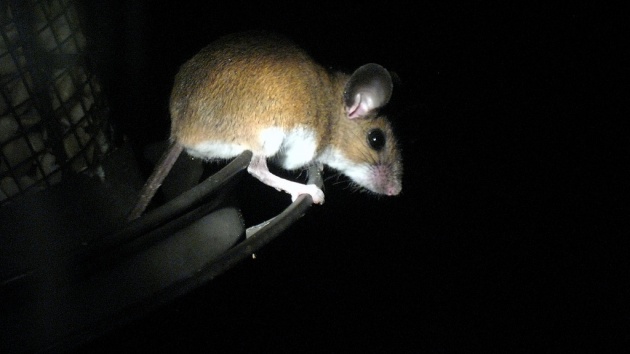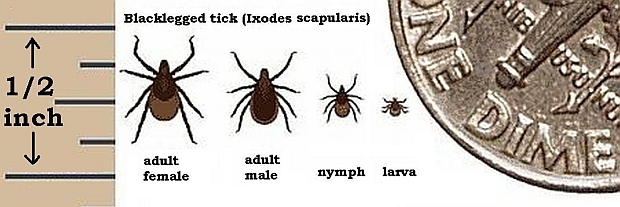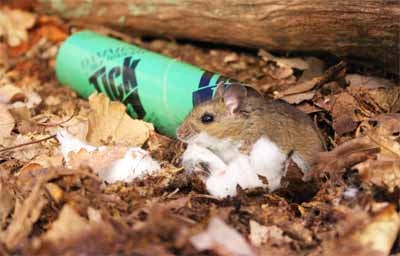
19 October 2016
If you live in a Lyme disease area and feed the birds, you might get Lyme disease in your own backyard. Here’s what makes that possible and how you can make your yard safe.
When you provide food for birds, a lot of other animals eat that food as well. Squirrels and chipmunks eat during the day. The mice come at night, especially white-footed mice pictured above at a peanut feeder.
Animals live close to their food sources so they live in your backyard or even your house. Here’s a favorite mouse and chipmunk home — the nooks and crannies of stone walls.

The abundance of birds and rodents in your yard attracts predators: hawks, owls, cats and even ticks. You’ll see the big predators but you might not notice the tiny ones. Adult black-footed ticks are very hungry in October and November so watch out.

Birdseed –> mice –> ticks –> Lyme disease. White-footed mice are reservoirs for Lyme disease so the black-footed ticks that feed on your backyard mice may be infected.
What to do?
It’s impossible to get rid of all the mice — even if you stop feeding the birds — but you can get rid of ticks, and that’s what counts in the battle against Lyme disease.
The mice will help you do it. Mice like soft fluffy bedding in their nests and will carry it into their secret hiding places. If you give them anti-tick bedding it kills the ticks on them and in their nests.
This ingenious defense can be bought at TickTubes: The Safe and Effective Solution for Tick Control. In TickEncounter’s photo below, a mouse is gathering anti-tick bedding — permethrin-sprayed cottonballs — from the blue-green tick tube.

Don’t make your own tick tubes. (You’ll not get the dosage right and Permethrin can poison cats!) Instead buy EPA certified tick tubes at ticktubes.com. And then …
No more ticks!
p.s. You’ll see at Tick Encounter that July and August are the optimal time for setting out Tick Tubes. Sorry my timing is off.
p.s. Be careful with Permethrin. READ AND FOLLOW ALL LABEL DIRECTIONS. It is very bad for pets!
(photo credits: Click on the images to see the originals in context
White-footed mouse at night by Rob Ireton, Creative Commons license on Flickr,
Stone wall photo from Wikimedia Commons,
Chart of black-legged tick life stages from Wikimedia Commons,
White-footed mouse with anti-tick tube and cottonball bedding from tickencounter.org)
Also: don’t scare away your opossum friends. They eat ticks by the pound.
I found out the hard way , Kate, that whitetail deer , abundant in our area , are hosts for ticks ; and that ticks live and breed in piles of fallen leaves. I wish I would have kept myself covered better last Fall when doing my yard and woodland chores , so as not to end up with Lymes disease last Winter . Thanks for these helpful tips ; you know what they say about an ounce of prevention.
Thank you Kate for letting people know that mice are the reservoir for Lyme disease (not white-tailed deer). But please also caution your readers about the dangers of Permethrin. Not only is Permethrin highly toxic to bees and other pollinators, but it is dangerous to pets at high doses also, as well as fish. That means if you put out these tubes and it rains the toxin can get into our streams and harm fish and invertebrates. Also. if you have a curious dog or cat around and they decide to eat these tubes you might have a sick pet, or even a life-threatening situation on your hands, depending on how much is ingested. And if you think there is no reason for a cat or dog to eat these tubes, just wait until it is visited by a mouse, and then see if the pet is interested in the mouse-y smelling tube.
I am not trying to discourage your readers from using this method of tick control, I use the chemical on my clothes, it can be sprayed on or you can buy clothes with the chemical already embedded. But, I have also seen many sick cats and almost lost a dog to insecticide poisoning.
Here is some more info: http://npic.orst.edu/factsheets/PermGen.html
Very interesting product; let the mice do the work!! Permethrin is great for ticks. I had sprayed part of my tent when camping one year and it killed the ticks pretty much on contact. One word of caution with permethrin, it is deadly for cats. Their systems can’t process it. I have 3 cats so I spray my clothes and equipment away from home.